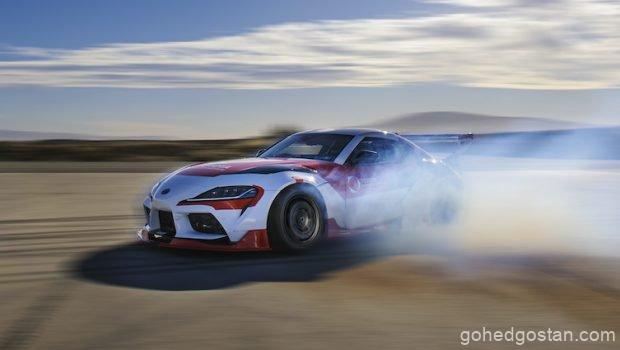Toyota Baru Mengajar Supra Cara Untuk Drift Secara Autonomi
Tentang teknologi memandu sendiri, cerita itu dah agak basi. Elon Musk menjadi berita utama bila dia memutuskan bahawa Tesla harus melancarkan ‘Autopilot’ tanpa menggunakan LiDAR (dan tanpa ia menjadi terlalu autonomi). Sejak itu, banyak syarikat telah menyatakan bahawa mereka mempunyai teknologi tanpa pemandu yang paling mutakhir yang benar-benar menangkap imaginasi orang ramai.

Baik, daripada mencuba dan membuat publisiti dari teknologi memandu sendiri, Toyota telah memutuskan untuk mereka self-drifting! Kerjasama antara Institut Penyelidikan Toyota dan Makmal Reka Bentuk Dinamik Standard telah mencipta GR Supra yang boleh drift tanpa pemandu! Kenapa? Ia memang sangat kool, tetapi ada alasan yang lebih mendalam: Toyota ingin tahu sama ada mereka boleh memberikan ‘refleks’ pemandu kenderaan lumba profesional kepada kereta pandu sendiri ini.
Dan mereka boleh. Ianya pula menjadi perkara yang sangat penting untuk keselamatan jalan raya. Kadang-kadang kemalangan tidak dapat dielakkan bukan hanya kerana kesalahan manusia, tetapi juga kerana keterbatasan manusia. Sebilangan besar pemandu tidak cukup pantas untuk bertindak balas terhadap situasi yang sangat tidak dijangka dan berbahaya walaupun mereka memberi perhatian dan membuat semua perkara teratur.

Adalah diharapkan dengan memberi keselamatan aktif kepada kereta yang mencerminkan kemahiran yang dimiliki oleh pemandu kereta lumba profesional, senario kemalangan jalan raya yang ekstrem dapat mengurangkan korban nyawa. Di negara-negara di mana jalan boleh membeku dan menjadi licin, sebuah kereta panduan sendiri mungkin tidak dapat mengimbangi kehilangan daya tarikan melalui tekanan brek. Sekiranya keadaan memungkinkan, pergerakan terkawal melalui ais mungkin merupakan jalan paling selamat.

Terus terang, cukup hebat.

Lebih banyak lagi maklumatdalam siaran media Toyota di bawah.
KENYATAAN MEDIA
Meet the world’s first (and only) self-drifting GR Supra, which has been created by a joint collaboration of researchers at Toyota Research Institute and Stanford’s Dynamic Design Lab, with the aim of reducing road traffic accidents.
Based around the question, ‘What if every driver who ran into trouble had the instinctive reflexes of a professional race car driver and the calculated foresight of a supercomputer to avoid a crash?’ the self-drifting GR Supra is seeking to combine the technology of vehicle automation with artificial intelligence algorithms.
Inspired by professional drift drivers, the engineers are conducting research on how to bring together the instincts of racing drivers and automated driving technology, with the self-drifting GR Supra as their testbed. The end goal is to design a new level of active safety technology and share it broadly so that Toyota and other auto manufacturers can deploy it on the road.
“Every day, there are deadly vehicle crashes that result from extreme situations where most drivers would need superhuman skills to avoid a collision,” said Gill Pratt, TRI CEO and Chief Scientist at Toyota Motor Corporation (TMC). “The reality is that every driver has vulnerabilities, and to avoid a crash, drivers often need to make manoeuvres that are beyond their abilities. Through this project, TRI will learn from some of the most skilled drivers in the world to develop sophisticated control algorithms that amplify human driving abilities and keep people safe. This is the essence of the Toyota Guardian™ approach.”
Every year, car crashes result in nearly 40,000 fatalities in the United States and about 1.25 million fatalities worldwide. Toyota’s goal is to reduce that number to zero. While most crashes occur in mundane situations, in other situations drivers may need to make manoeuvres that take their vehicle close to and, at times, exceed normal limits of handling. When faced with wet or slippery roads, for instance, professional drivers may choose to ‘drift’ the car through a turn.
“Since 2008, our lab has taken inspiration from human race car drivers in designing algorithms that enable automated vehicles to handle the most challenging emergencies,” said Professor Chris Gerdes of Stanford University’s Dynamic Design Laboratory. “Through this research, we have the opportunity to move these ideas much closer to saving lives on the road.”
TRI has supported the Dynamic Design Lab’s research for many years. The current project draws upon Stanford’s published paper, “Opening New Dimensions: Vehicle Motion Planning and Control using Brakes while Drifting,” in which Stanford researchers demonstrated advanced drifting on MARTY, an electrified, automated DeLorean. Stanford’s experimental results produced a proof-of-concept architecture capable of controlling a rear-wheel-drive vehicle in a drift using brakes, steering and propulsion. TRI is now applying this architecture to vehicle platforms, including the GR Supra.
TRI is also engaging Toyota’s engineering expertise in motorsports and advanced development. Toyota Racing Development in the United States is providing valuable technical and experiential know-how in motorsports and drifting. Separately, TRI is also working with Toyota Motor Corporation’s Vehicle Dynamics Control Team — based in Japan — to apply the drifting architecture for future Toyota vehicles.







No Comment